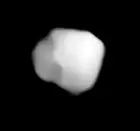29 Amphitrite
Amphitrite (minor planet designation: 29 Amphitrite) is one of the largest S-type asteroids, approximately 200 kilometers (120 miles) in diameter, and probably fifth largest after Eunomia, Juno, Iris and Herculina.
 VLT image of Amphitrite | |
| Discovery [1] | |
|---|---|
| Discovered by | A. Marth |
| Discovery site | London |
| Discovery date | 1 March 1854 |
| Designations | |
| (29) Amphitrite | |
| Pronunciation | /æmfɪˈtraɪtiː/[2] |
Named after | Amphitrite [3] (Greek mythology) |
| A899 NG | |
| main-belt [1][4] · (middle) background [5][6] | |
| Adjectives | Amphitritean /ˌæmfɪtrɪˈtiːən/, /ˌæmfɪˈtraɪtiən/ |
| Orbital characteristics [4] | |
| Epoch 23 March 2018 (JD 2458200.5) | |
| Uncertainty parameter 0 | |
| Observation arc | 162.83 yr (59,472 d) |
| Aphelion | 2.7400 AU |
| Perihelion | 2.3712 AU |
| 2.5556 AU | |
| Eccentricity | 0.0722 |
| 4.09 yr (1,492 d) | |
| 187.97° | |
| 0° 14m 28.68s / day | |
| Inclination | 6.0823° |
| 356.37° | |
| 63.036° | |
| Physical characteristics | |
| Dimensions | 233 km × 212 km × 193 km[7] |
Mean diameter | 189.559±1.129 km[8] 196±22 km[9] 206.86 km[10] 212.22±6.8 km[11] 227.149±3.975 km[12] |
| Mass | 1.18×1019 kg[7] |
Mean density | 2.36±0.26 g/cm3[7] |
| 5.3921 h[13][6] | |
| 0.1568±0.0348[12] 0.1793±0.012[11] 0.195[10] 0.216±0.043[8] | |
| S [6] | |
| 5.85[1][4] 6.0[5] | |
Discovery
Amphitrite was discovered by Albert Marth on 1 March 1854, at the private South Villa Observatory, in Regent's Park, London. It was Marth's only asteroid discovery. Its name was chosen by George Bishop, the owner of the observatory, who named it after Amphitrite, a sea goddess in Greek mythology.[3]
Characteristics
.png.webp)
Amphirite's orbit is less eccentric and inclined than those of its larger cousins; indeed, it is the most circular of any asteroid discovered up to that point. As a consequence, it never becomes as bright as Iris or Hebe, especially as it is much further from the Sun than those asteroids. It can reach magnitudes of around +8.6 at a favorable opposition, but usually is around the binocular limit of +9.5.
Asteroid 29 Amphitrite will again be visible at 13:24 on Sunday, 13 October 2019. It will be convenient to observe 29 Amphitrite from the constellation Pisces, well above Sydney's horizon for the greater part of the night.[14]
In 2007, James Baer and Steven R. Chesley estimated Amphitrite to have a mass of 1.9×1019 kg.[15] A more recent estimate by Baer suggests it has a mass of 1.18×1019 kg.[7]
A satellite of the asteroid is suspected to exist, based on lightcurve data collected by Edward F. Tedesco.[16][17] In 1988 a search for satellites or dust orbiting this asteroid was performed using the UH88 telescope at the Mauna Kea Observatories, but the effort came up empty.[18]
References
- "29 Amphitrite". Minor Planet Center. Retrieved 1 June 2018.
- Noah Webster (1884) A Practical Dictionary of the English Language
- Schmadel, Lutz D. (2007). "(29) Amphitrite". Dictionary of Minor Planet Names – (29) Amphitrite. Springer Berlin Heidelberg. p. 18. doi:10.1007/978-3-540-29925-7_30. ISBN 978-3-540-00238-3.
- "JPL Small-Body Database Browser: 29 Amphitrite" (2018-05-23 last obs.). Jet Propulsion Laboratory. Retrieved 1 June 2018.
- "Asteroid (29) Amphitrite". AstDyS-2, Asteroids – Dynamic Site. Retrieved 25 May 2018.
- "Asteroid 29 Amphitrite". Small Bodies Data Ferret. Retrieved 1 June 2018.
- Jim Baer (2008). "Recent Asteroid Mass Determinations". Personal Website. Archived from the original on 2 July 2013. Retrieved 27 November 2008.
- Masiero, Joseph R.; Grav, T.; Mainzer, A. K.; Nugent, C. R.; Bauer, J. M.; Stevenson, R.; et al. (August 2014). "Main-belt Asteroids with WISE/NEOWISE: Near-infrared Albedos". The Astrophysical Journal. 791 (2): 11. arXiv:1406.6645. Bibcode:2014ApJ...791..121M. doi:10.1088/0004-637X/791/2/121. S2CID 119293330.
- Hanus, J.; Marchis, F.; Durech, J. (September 2013). "Sizes of main-belt asteroids by combining shape models and Keck adaptive optics observations". Icarus. 226 (1): 1045–1057. arXiv:1308.0446. Bibcode:2013Icar..226.1045H. doi:10.1016/j.icarus.2013.07.023. S2CID 118710558.
- Usui, Fumihiko; Kuroda, Daisuke; Müller, Thomas G.; Hasegawa, Sunao; Ishiguro, Masateru; Ootsubo, Takafumi; et al. (October 2011). "Asteroid Catalog Using Akari: AKARI/IRC Mid-Infrared Asteroid Survey". Publications of the Astronomical Society of Japan. 63 (5): 1117–1138. Bibcode:2011PASJ...63.1117U. doi:10.1093/pasj/63.5.1117. Retrieved 17 October 2019. (online, AcuA catalog p. 153)
- Tedesco, E. F.; Noah, P. V.; Noah, M.; Price, S. D. (October 2004). "IRAS Minor Planet Survey V6.0". NASA Planetary Data System. 12: IRAS-A-FPA-3-RDR-IMPS-V6.0. Bibcode:2004PDSS...12.....T. Retrieved 22 October 2019.
- Mainzer, A.; Grav, T.; Masiero, J.; Hand, E.; Bauer, J.; Tholen, D.; et al. (November 2011). "NEOWISE Studies of Spectrophotometrically Classified Asteroids: Preliminary Results". The Astrophysical Journal. 741 (2): 25. arXiv:1109.6407. Bibcode:2011ApJ...741...90M. doi:10.1088/0004-637X/741/2/90. S2CID 118700974. (catalog)
- "LCDB Data for (29) Amphitrite". Asteroid Lightcurve Database (LCDB). Retrieved 1 June 2018.
- Ford, Dominic. "Asteroid 29 Amphitrite at opposition". Guides to the night sky. in-the-sky.org. Retrieved 2 April 2019.
- Baer, James; Steven R. Chesley (2008). "Astrometric masses of 21 asteroids, and an integrated asteroid ephemeris". Celestial Mechanics and Dynamical Astronomy. 100 (2008): 27–42. Bibcode:2008CeMDA.100...27B. doi:10.1007/s10569-007-9103-8.
- Tedesco, E. F. (March 1979). "Binary Asteroids: Evidence for Their Existence from Lightcurves". Science. New Series. 203 (4383): 905–907. Bibcode:1979Sci...203..905T. doi:10.1126/science.203.4383.905. PMID 17771729. S2CID 19431574.
- van Flandern, T. C.; Tedesco, E. F.; Binzel, R. P. (1979). "Satellites of asteroids". Asteroids. Tucson, AZ: University of Arizona Press. pp. 443–465. Bibcode:1979aste.book..443V.
- Gradie, J.; Flynn, L. (March 1988), "A Search for Satellites and Dust Belts Around Asteroids: Negative Results", Abstracts of the Lunar and Planetary Science Conference, 19, pp. 405–406, Bibcode:1988LPI....19..405G
External links
- Discovery Circumstances: Numbered Minor Planets (1)-(5000) – Minor Planet Center
- 29 Amphitrite at AstDyS-2, Asteroids—Dynamic Site
- 29 Amphitrite at the JPL Small-Body Database
